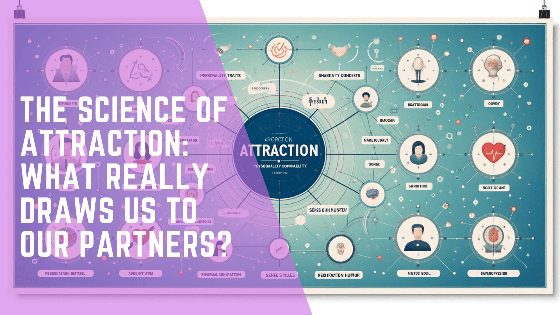

Why are we drawn to some individuals more than others? The Science of Attraction encompasses much more than mere physical appearances; it involves a complex blend of psychological factors, biological influences, and social dynamics. In this detailed exploration, we delve into the various elements of attraction research to uncover what ignites the spark between people.
The Psychological Factors in the Science of Attraction
Understanding why we are attracted to certain people often starts in the mind. Psychological factors in the Science of Attraction encompass a broad range of elements including shared values, emotional intelligence, and personality traits. These factors are crucial because they determine how well we can connect with another person on a deeper, more personal level.
Shared values are foundational to developing strong, enduring relationships. When two people hold similar beliefs and values, they are more likely to experience greater harmony and fewer conflicts. For instance, if both partners value family, honesty, or ambition highly, they are likely to support each other’s life decisions and goals, creating a strong bond that enhances mutual respect and understanding.
Emotional intelligence (EI) plays a significant role in the dynamics of attraction. EI involves the ability to understand and manage one’s own emotions, as well as the emotions of others. People with high emotional intelligence are often more empathetic and can communicate more effectively, which are essential skills in nurturing a healthy relationship. They are better at resolving conflicts, navigating the emotional landscape of their relationships, and creating a supportive, loving environment.
Personality traits also heavily influence attraction. The complementarity and similarity of personality traits can significantly affect how relationships form and develop. For example, introverts might find themselves drawn to extroverts who bring a balance of energy and social interaction to their lives. Similarly, people often seek partners whose level of conscientiousness or openness matches their own, as these traits impact daily interactions and long-term goals.
Research suggests that we are naturally inclined towards individuals who reflect a version of ourselves. This phenomenon, known as “mirroring,” involves the subconscious attraction to those who exhibit similar behaviors, attitudes, or reactions. Mirroring can foster a deeper connection and a sense of understanding between partners because it reinforces a shared way of experiencing the world. It is comforting and affirming to see our own traits and values reflected in someone else, which can lead to a stronger and more empathetic partnership.
This mirroring effect underscores the importance of psychological compatibility in forming lasting relationships. When partners understand and resemble each other psychologically, they are better equipped to anticipate each other’s needs, provide mutual support, and navigate life’s challenges together. Ultimately, these psychological connections can lead to a fulfilling and resilient relationship, enriched by a deep understanding and appreciation of each other.


Biological Influences on Attraction Our biological makeup plays a critical role in attraction. Pheromones, those invisible chemical signals that each of us emits, affect our attraction to others on a subconscious level. Additionally, genetic compatibility, such as the attraction to partners with different immune system genes, suggests that biology could be steering us toward partners who enhance the potential health of our offspring. Evolutionary theories also propose that traits such as physical symmetry and youthfulness are favored because they signal health and fertility.
Social Dynamics and Their Impact on Attraction Social dynamics, including cultural norms and societal expectations, significantly influence whom we find attractive. For instance, varying standards of beauty across cultures can dictate who catches our eye. Furthermore, socioeconomic factors often play a subtle yet powerful role in attraction, with some studies suggesting that people tend to form relationships within similar economic backgrounds, enhancing social compatibility. This segment of the Science of Attraction highlights how societal influences intertwine with personal choices in the realm of romantic relationships.
Exploring Current Trends in Attraction Research Recent advancements in technology and psychology have brought new insights into how we understand and experience attraction. For instance, online dating platforms have introduced a digital aspect to attraction, allowing individuals to connect based on algorithms that predict compatibility. These platforms provide a fascinating glimpse into how modern tech intersects with age-old human behaviors, revealing patterns and preferences that continue to shape the romantic landscape.
Conclusion: The Science of Attraction is a rich and dynamic field that offers profound insights into the natural forces driving our romantic choices. By understanding the intricate dance of psychological factors, biological influences, and social dynamics, we gain not only a deeper knowledge of human nature but also practical guidance for nurturing our own relationships. Whether you’re curious about why you’re attracted to certain types of people or seeking to enrich your current relationship, appreciating these underlying mechanisms can empower you to approach your romantic life with greater awareness and intention.

Leave a Reply